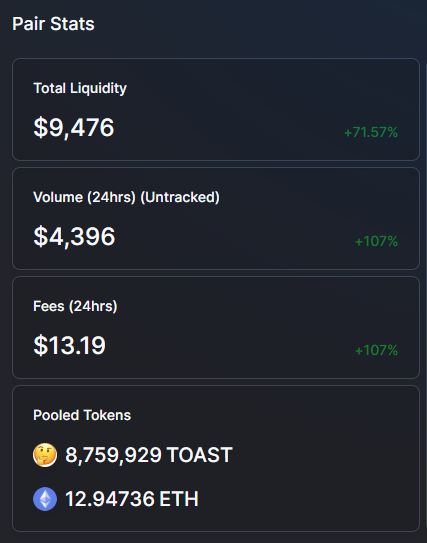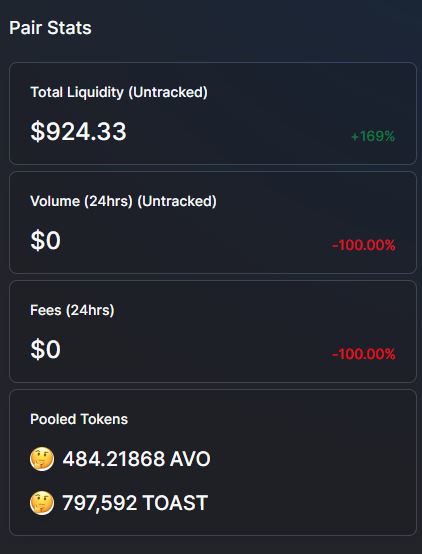toast.finance My First DeFi Farming Experiment
Alex Barry | Fri Sep 11 2020
The cryptocurrency space has been evolving at a rapid pace in 2020, with DeFi leading the hype train, but what is DeFi? DeFi is short for decentralized finance, which is a broad term for any financial system that can take place without any intermediary, the first ever decentralized financial application was Bitcoin. In more recent trends DeFi has started referring to various applications built by smart contracts, usually on the Ethereum blockchain. A large part of the recent growth in DeFi has been in the yield farming sector, the aim of yield farming to gain rewards for using tokens you are already holding. This process typically involves depositing your tokens into a smart contract, which carries a great deal of risk if the contract has not been properly audited.
Over 4 years ago I invested in theDAO and learned first hand that depositing tokens in an unaudited contract carried great risk, so originally I thought the hype around DeFi would fade away quickly because each “DeFi'' project looks like another DAO hack waiting to happen. However I observed Uniswap gaining a tremendous amount of liquidity in July and August, and realized this trend was something I could no longer ignore, so I finally decided to experiment with Yield Farming.
My first farming experience with DeFi took place in the toast.finance ecosystem, which has 4 native tokens, HOUSE, Avocado(AVO), EGGS, and TOAST. The first tokens created were HOUSE, which has a limited supply of 20,000 tokens, along with AVO and EGGS each of which have a limited supply of 100,000. HOUSE is a governance token that allows users to vote for proposed changes to the TOAST ecosystem. AVO and EGGs tokens could be earned as rewards for adding liquidity to the HOUSE/ETH uniswap liquidity pool(LP) and then staking the LP token you got in the toast.finance smart contract. On September 8th I purchased my first HOUSE tokens for $15 each and joined their telegram group, and was informed that the developer of HOUSE was just finishing up a fork of the SushiChef contract for a token called TOAST, that could be earned by staking various Uniswap LP token pairs in the ecosystem. The initial reward pairs were HOUSE/ETH, TOAST/ETH, HOUSE/AVO, HOUSE/EGGS, HOUSE/TOAST, AVO/EGGS AVO/TOAST and EGGS/TOAST.
As you can see the initial yields for all the TOAST pairs were insane, so I decided to experiment and see if the pools were showing the correct yields(they were), I decided to go with all of the TOAST pairs, because this is toast.finance after all. To begin I converted some of my HOUSE tokens into EGGS and AVO through uniswap, and purchased TOAST with ETH. Then I deposited tokens into each specified liquidity pool. I put roughly $50 of each token and $50 of TOAST into each pool to start, and waited to see how much I would be yielded in TOAST. To my surprise, the AVO/TOAST and EGGS/TOAST pairs were yielding substantially more rewards than the TOAST/ETH pair. The developer, Cryptoastio, explained that each pool was allocated 1/8th of the 1000 TOAST that were issued per block. The rewards you got from each TOAST reward pool were proportional to the % of liquidity that you contributed in the uniswap LP for that pair, because AVO/TOAST and EGGS/TOAST are obscure pairs with low liquidity, it was easy to gain a majority of the liquidity pools for both those pairs and rake in large amounts of this new TOAST token. However the fun of having a large stream of the rewards would not last, the developer realized there was not enough incentive for people to contribute to the TOAST/ETH and HOUSE/ETH liquidity pairs, so the rewards for them were increased, while the rewards for other pools were lowered. This was a bittersweet feeling, while I was able to farm a fewer number of toasts, the incentives for increased liquidity on the TOAST/ETH pair means the TOAST I have farmed has a better chance of being worth more in the future.
As you can see, the rewards have substantially decreased from the insane levels on day 1
I learned many valuable things from my first farming experience, and I hope you readers will be able to apply some of these lessons if you would like to experiment with DeFI yield farming.
- When pool rewards are evenly distributed (no pool had special weight), the more obscure pairs require less capital to gain a substantial % of the liquidity pool, and the greater the rewards will be, these are the best pools to farm in because they have low risk and high reward, however the yields they offer will only be available for a limited time.
- It is problematic for a project to not have enough rewards on its token/ETH pair because there is not enough incentive for people to contribute ETH liquidity to the project, and it will be dumped infinitely
- The best time to start farming a project is the first day it is available if possible, I was able to take my early TOAST rewards and stake them again, to ensure I had a large % of the liquidity pool.
What is next for the toast.finance ecosystem? It is completely up to the community! Anybody that holds at least 50 HOUSE tokens can create a proposal to the governance system and help steer the community, I am looking forward to the direction that the TOAST community will take this project!
The https://quantifycrypto.com/ platform provides live cryptocurrency prices, technical analysis, news, heatmaps and more. Our flagship product is the trend algorithm, designed to be on the correct side of significant cryptocurrency price moves. We are a new site, please check us out and let us know what you like and do not like about the site. None of this is meant to be financial advice and I do not have any financial expertise. Although I worked at the New York Stock Exchange for over 23 years, it was as a developer supporting computer systems, not as a stock trader. Full discloser: I do own Bitcoin and have stock positions.

